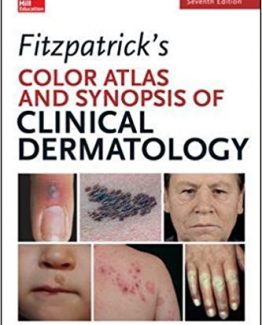Abnormal Child Psychology 7th Edition by Eric J. Mash, ISBN-13: 978-1337624268
[PDF eBook eTextbook] – Available Instantly
- Publisher: Cengage Learning; 7th edition (January 1, 2018)
- Language: English
- 672 pages
- ISBN-10: 1337624268
- ISBN-13: 978-1337624268
ABNORMAL CHILD PSYCHOLOGY, 7th Edition introduces you to childhood and adolescent disorders, treatment, and prevention using an approach that recognizes the interconnectedness of biological, psychological, social, and emotional influences. You’ll view each disorder from the perspective of the whole child, with diagnostic criteria as well as emphasis on the strengths of the individual, environmental circumstances, issues pertaining to younger and older age groups, and the risk and protective factors affecting developmental pathways. Case histories, examples, and first-person accounts are at the heart of the text, bringing to life theories, disorders, and the real people who are affected by them.
Table of Contents:
Cover Page
Title Page
Copyright Page
Preface
Part 1. Understanding Abnormal Child Psychology
Chapter 1. Introduction to Normal and Abnormal Behavior in Children and Adolescents
Historical Views and Breakthroughs
The Emergence of Social Conscience
Early Biological Attributions
Early Psychological Attributions
Evolving Forms of Treatment
Progressive Legislation
What Is Abnormal Behavior in Children and Adolescents?
Defining Psychological Disorders
Competence
Developmental Pathways
Risk and Resilience
The Significance of Mental Health Problems among Children and Youths
The Changing Picture of Children’s Mental Health
What Affects Rates and Expression of Mental Disorders? A Look at Some Key Factors
Poverty and Socioeconomic Disadvantage
Sex Differences
Race and Ethnicity
Cultural Issues
Child Maltreatment and Non-Accidental Trauma
Special Issues Concerning Adolescents and Sexual Minority Youths
Lifespan Implications
Looking Ahead
Study Resources
Chapter 2. Theories and Causes
What Is Causing Jorge’s Problems?
Theoretical Foundations
Developmental Psychopathology Perspective
An Integrative Approach
Developmental Considerations
Organization of Development
Biological Perspectives
Neural Plasticity and the Role of Experience
Genetic Contributions
Neurobiological Contributions
Psychological Perspectives
Emotional Influences
Behavioral and Cognitive Influences
Applied Behavior Analysis (ABA)
Family, Social, and Cultural Perspectives
Infant–Caregiver Attachment
The Family and Peer Context
Looking Ahead
Study Resources
Chapter 3. Research
A Scientific Approach
When Science Is Ignored
The Research Process
Common Research Questions and Topics
Methods of Studying Behavior
Standardization, Reliability, and Validity
Measurement Methods
Reporting Methods
Psychophysiological Methods
Neuroimaging Methods
Observation Methods
Research Strategies
Identifying the Sample
General Research Strategies
Research Designs
Qualitative Research
Ethical and Pragmatic Issues
Informed Consent and Assent
Voluntary Participation
Confidentiality and Anonymity
Nonharmful Procedures
Other Ethical and Pragmatic Concerns
Study Resources
Chapter 4. Assessment, Diagnosis, and Treatment
Clinical Issues
The Decision-Making Process
Developmental Considerations
Purposes of Assessment
Assessing Disorders
Clinical Interviews
Behavioral Assessment
Psychological Testing
Classification and Diagnosis
Categories and Dimensions
The Diagnostic and Statistical Manual of Mental Disorders (DSM-5)
Treatment and Prevention
Intervention
Cultural Considerations
Treatment Goals
Ethical and Legal Considerations
General Approaches to Treatment
Treatment Effectiveness
New Directions
Study Resources
Part 2. Neurodevelopmental Disorders
Chapter 5. Intellectual Disability (Intellectual Developmental Disorder)
Intelligence and Intellectual Disability
The Eugenics Scare
Defining and Measuring Children’s Intelligence and Adaptive Behavior
The Controversial IQ
Features of Intellectual Disabilities
Clinical Description
Severity Levels
Prevalence
Developmental Course and Adult Outcomes
Motivation
Changes in Abilities
Language and Social Behavior
Emotional and Behavioral Problems
Other Physical and Health Disabilities
Causes
Inheritance and the Role of the Environment
Genetic and Constitutional Factors
Neurobiological Influences
Social and Psychological Dimensions
Prevention, Education, and Treatment
Prenatal Education and Screening
Psychosocial Treatments
Study Resources
Chapter 6. Autism Spectrum Disorder and Childhood-Onset Schizophrenia
Autism Spectrum Disorder (ASD)
Description and History
DSM-5: Defining Features of ASD
ASD across the Spectrum
Core Deficits of ASD
Social Interaction and Communication Deficits
Restricted and Repetitive Behaviors and Interests
Associated Characteristics of ASD
Intellectual Deficits and Strengths
Cognitive and Motivational Deficits
Medical Conditions and Physical Characteristics
Accompanying Disorders and Symptoms
Prevalence and Course of ASD
Age at Onset
Course and Outcomes
Causes of ASD
Problems in Early Development
Genetic Influences
Brain Abnormalities
ASD as a Disorder of Risk and Adaptation
Treatment of ASD
Overview
Early Intervention
Medications
Childhood-Onset Schizophrenia (COS)
DSM-5: Defining Features of Schizophrenia
Positive Symptoms
Precursors and Comorbidities
Prevalence
Causes and Treatment of COS
Causes
Treatment
Study Resources
Chapter 7. Communication and Learning Disorders
Definitions and History
Language Development
Phonological Awareness
Communication Disorders
Language and Speech Sound Disorders
Childhood-Onset Fluency Disorder (Stuttering)
Social (Pragmatic) Communication Disorder
Specific Learning Disorder
SLD with Impairment in Reading
SLD with Impairment in Written Expression
SLD with Impairment in Mathematics
Study Resources
Chapter 8. Attention-Deficit/Hyperactivity Disorder (ADHD)
Description and History
Description
History
Core Characteristics
Inattention
Hyperactivity–Impulsivity
Presentation Type
Additional DSM Criteria
What DSM Criteria Don’t Tell Us
Associated Characteristics
Cognitive Deficits
Speech and Language Impairments
Medical and Physical Concerns
Social Problems
Accompanying Psychological Disorders and Symptoms
Oppositional Defiant Disorder and Conduct Disorder
Anxiety Disorders
Mood Disorders
Developmental Coordination and Tic Disorders
Prevalence and Course
Gender
Socioeconomic Status and Culture
Course and Outcome
Theories and Causes
Genetic Influences
Pregnancy, Birth, and Early Development
Neurobiological Factors
Diet, Allergy, and Lead
Family Influences
Treatment
Medication
Parent Management Training (PMT)
Educational Intervention
Intensive Interventions
Additional Interventions
A Comment on Controversial Treatments
Keeping Things in Perspective
Study Resources
Part 3. Behavioral and Emotional Disorders
Chapter 9. Conduct Problems
Description of Conduct Problems
Context, Costs, and Perspectives
Context
Social and Economic Costs
Perspectives
DSM-5: Defining Features
Oppositional Defiant Disorder (ODD)
Conduct Disorder (CD)
Antisocial Personality Disorder (APD) and Psychopathic Features
Associated Characteristics
Cognitive and Verbal Deficits
School and Learning Problems
Family Problems
Peer Problems
Self-Esteem Deficits
Health-Related Problems
Accompanying Disorders and Symptoms
Attention-Deficit/Hyperactivity Disorder (ADHD)
Depression and Anxiety
Prevalence, Gender, and Course
Prevalence
Gender
Developmental Course and Pathways
Adult Outcomes
Causes
Genetic Influences
Prenatal Factors and Birth Complications
Neurobiological Factors
Social–Cognitive Factors
Family Factors
Other Family Problems
Societal Factors
Cultural Factors
Treatment and Prevention
Parent Management Training (PMT)
Problem-Solving Skills Training (PSST)
Multisystemic Therapy (MST)
Preventive Interventions
Study Resources
Chapter 10. Depressive and Bipolar Disorders
Overview of Mood Disorders
Depressive Disorders
History
Depression in Young People
Depression and Development
Anatomy of Depression
Major Depressive Disorder (MDD)
Prevalence
Comorbidity
Onset, Course, and Outcome
Gender
Ethnicity and Culture
Persistent Depressive Disorder [P-DD] (Dysthymia)
Prevalence and Comorbidity
Onset, Course, and Outcome
Disruptive Mood Dysregulation Disorder (DMDD)
Associated Characteristics of Depressive Disorders
Intellectual and Academic Functioning
Cognitive Biases and Distortions
Negative Self-Esteem
Social and Peer Problems
Family Problems
Depression and Suicide
Theories of Depression
Psychodynamic
Attachment
Behavioral
Cognitive
Other Theories
Causes of Depression
Genetic and Family Risk
Neurobiological Influences
Family Influences
Stressful Life Events
Emotion Regulation
Treatment of Depression
Psychosocial Interventions
Medications
Prevention
Bipolar Disorder (BP)
Prevalence
Comorbidity
Onset, Course, and Outcome
Causes
Treatment
Study Resources
Chapter 11. Anxiety and Obsessive–Compulsive Disorders
Description of Anxiety Disorders
Experiencing Anxiety
Anxiety versus Fear and Panic
Normal Fears, Anxieties, Worries, and Rituals
Anxiety Disorders According to DSM-5
Separation Anxiety Disorder
Prevalence and Comorbidity
Onset, Course, and Outcome
School Reluctance and Refusal
Specific Phobia
Prevalence and Comorbidity
Onset, Course, and Outcome
Social Anxiety Disorder (Social Phobia)
Prevalence, Comorbidity, and Course
Selective Mutism
Prevalence, Comorbidity, and Course
Panic Disorder and Agoraphobia
Prevalence and Comorbidity
Onset, Course, and Outcome
Generalized Anxiety Disorder
Prevalence and Comorbidity
Onset, Course, and Outcome
Obsessive–Compulsive and Related Disorders
Obsessive–Compulsive Disorder
Prevalence and Comorbidity
Onset, Course, and Outcome
Associated Characteristics
Cognitive Disturbances
Physical Symptoms
Social and Emotional Deficits
Anxiety and Depression
Gender, Ethnicity, and Culture
Theories and Causes
Early Theories
Temperament
Family and Genetic Risk
Neurobiological Factors
Family Factors
Treatment and Prevention
Overview
Behavior Therapy
Cognitive–Behavioral Therapy (CBT)
Family Interventions
Medications
Prevention
Study Resources
Chapter 12. Trauma- and Stressor-Related Disorders
History and Family Context
Healthy Families
Continuum of Care
Trauma, Stress, and Maltreatment: Defining Features
Trauma and Stress
Maltreatment
Characteristics of Children Who Suffer Maltreatment
Family Context
Causes of Maltreatment
Trauma- and Stressor-Related Disorders
Reactive Attachment Disorder
Disinhibited Social Engagement Disorder
Post-traumatic Stress Disorder
Treatment and Prevention
Exposure-Based Therapy
Special Needs of Maltreated Children
Study Resources
Part 4. Developmental and Learning Disorders
Chapter 13. Health-Related and Substance-Use Disorders
History
Sleep–Wake Disorders
The Regulatory Functions of Sleep
Maturational Changes
Features of Sleep–Wake Disorders
Treatment
Elimination Disorders
Enuresis
Encopresis
Chronic Illness
Normal Variations in Children’s Health
Diabetes Mellitus
Childhood Cancer
Development and Course
How Children Adapt: A Biopsychosocial Model
Intervention
Adolescent Substance-Use Disorders
Prevalence and Course
Causes
Treatment and Prevention
Study Resources
Chapter 14. Feeding and Eating Disorders
How Eating Patterns Develop
Normal Development
Developmental Risk Factors
Biological Regulators
Obesity
Prevalence and Development
Causes
Treatment
Feeding and Eating Disorders First Occurring in Infancy and Early Childhood
Avoidant/Restrictive Food Intake Disorder
Pica
Eating Disorders of Adolescence
Anorexia Nervosa
Bulimia Nervosa
Binge Eating Disorder
Prevalence and Development
Causes
Treatment
Study Resources
References
Eric J. Mash is a professor of psychology at the University of Calgary in Canada, where he enjoys teaching undergraduate classes in child psychopathology, behavior modification and developmental psychopathology, as well as graduate classes in clinical psychology, specifically in child psychopathology, child assessment and child psychotherapy. He earned his Ph.D. in clinical psychology at Florida State University and completed his residency in clinical child psychology at Oregon Health and Sciences University in Portland, Oregon. Eric commits much of his time and energy outside the classroom to researching the topics of child psychopathology, child and family assessment, child psychotherapy and child development. Particularly interested in attention-deficit disorder and conduct problems and in families in which children have been physically abused, Eric has contributed and published many journal articles and books on these topics. He is also a Fellow of the American and Canadian Psychological Associations and has served on the editorial boards of many prestigious journals and grant agencies at local and federal levels.
David Wolfe is the first recipient of the RBC Investments Chair in Developmental Psychopathology and Children’s Mental Health at the Centre for Addiction and Mental Health, University of Toronto, and the Academic Director of the Center for Research on Violence Against Women and Children. He enjoys teaching child psychopathology, child assessment and psychotherapy and community psychology to undergraduate students. He earned his Ph.D. at the University of South Florida in Tampa and completed his residency in clinical psychology at the University of Mississippi Medical Center. David is a founding member of the Center for Research on Violence Against Women and Children and a fellow of the American Psychological Association (APA), where he served as president of Division 37: Child, Youth, and Family Services. He lends special focus to child abuse, domestic violence and development and developmental psychopathology, as well as the impact of early childhood trauma on later development in childhood, adolescence and early adulthood. Currently, David focuses on studying ways to prevent violence in relationships with adolescents.
What makes us different?
• Instant Download
• Always Competitive Pricing
• 100% Privacy
• FREE Sample Available
• 24-7 LIVE Customer Support






Reviews
There are no reviews yet.